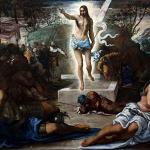John Milbank gave a very long, very dense lecture (amusingly interrupted by microphone problems and a fire-alarm evacuation of the hotel) on Sophiology and theurgy, drawing mainly on Bulgakov. I can’t say that I understood all that was going on, but I resonated to one respondent who asked why Sophia was necessary at all.
As Milbank unpacked Bulgakov, Sophia is many things. Sophia is a principle of mediation that does not stand “between” the two poles that it mediates but stands equally at both poles. so that there is an attunement or echo from one pole to the other; it is not a middle though it does all the work that a middle does. Sophia is also the reality of the “creation within God” and “God within the creation.”
For Bulgakov, or at least for Milbank’s Bulgakov, there is a heavenly and an earthly Sophia. The heavenly Sophia is the essence of God, which is quasi-personal without being a person, and which tends toward personhood. The earthly Sophia is the “World-Soul,” a Bergsonian elan vital, that is the principle of dynamism and growth within the creation.
Milbank appealed to Sophia to work out some apparent problems in Trinitarian theology. According to the orthodox tradition, there is no “third term” between the essence and the persons, nor between the persons. But, Milbank argued, if there is no mediation at all, then (for instance) the engendered Son becomes a “sheer Other” to the engendering Father, and the Triune persons fall into a dualism of “process and upshot,” which, he claimed, undoes the idea that the persons are substantive relations. So, there is no mediation; yet there has to be mediation. He made a similar argument regarding the relation of the essence to the Persons. What is common to the persons cannot be a person, but it also cannot be impersonal because it “personalizes” as the Three Persons.
It is difficult to see how this works without collapsing into quaternity or modalism. It seems that to think of the essence and persons as two “poles” that need to be mediated (even if there is no space or interval between the poles and even if the two poles are ultimately one) sets us off in a modalist direction from the beginning. It appears to assume that there is an un-hypostatized essence (or surplus of essence) that is not exhaustively personalized as Father, Son, and Spirit. If not in reality, at least conceptually, it seems that in Bulgakov’s model the essence is thought without simultaneously (or in the next mental breath) the thought of the three. This was more strongly suggested by Milbank’s offhand comments about the feminine gender of Sophia; perhaps, he suggested, the ultimately reality of the Christian God is feminine – a goddess. But, besides all the obvious problems with that, this assumes that the essence is the “reality” of God in a way that the persons are not, a God behind God.
Further, God’s relation to the world seems to be wholly explicable (insofar as it is explicable) without any appeal to a fourth term alongside the Three Persons. The Spirit is in the world from the first moment, and He is the immanent principle of growth and movement within the creation. With a strong creation pneumatology there doesn’t seem to be any need for Sophia.
Along the way, Milbank made some intriguing observations and historical connections, but the overall project, if I have understood it correctly, seems badly flawed.















